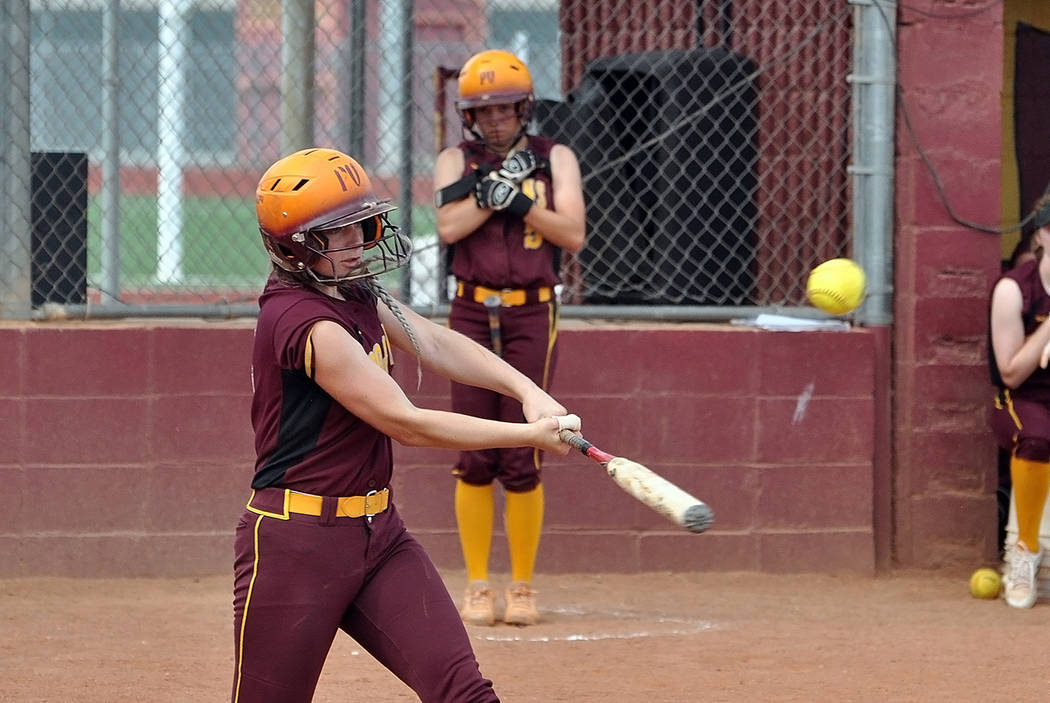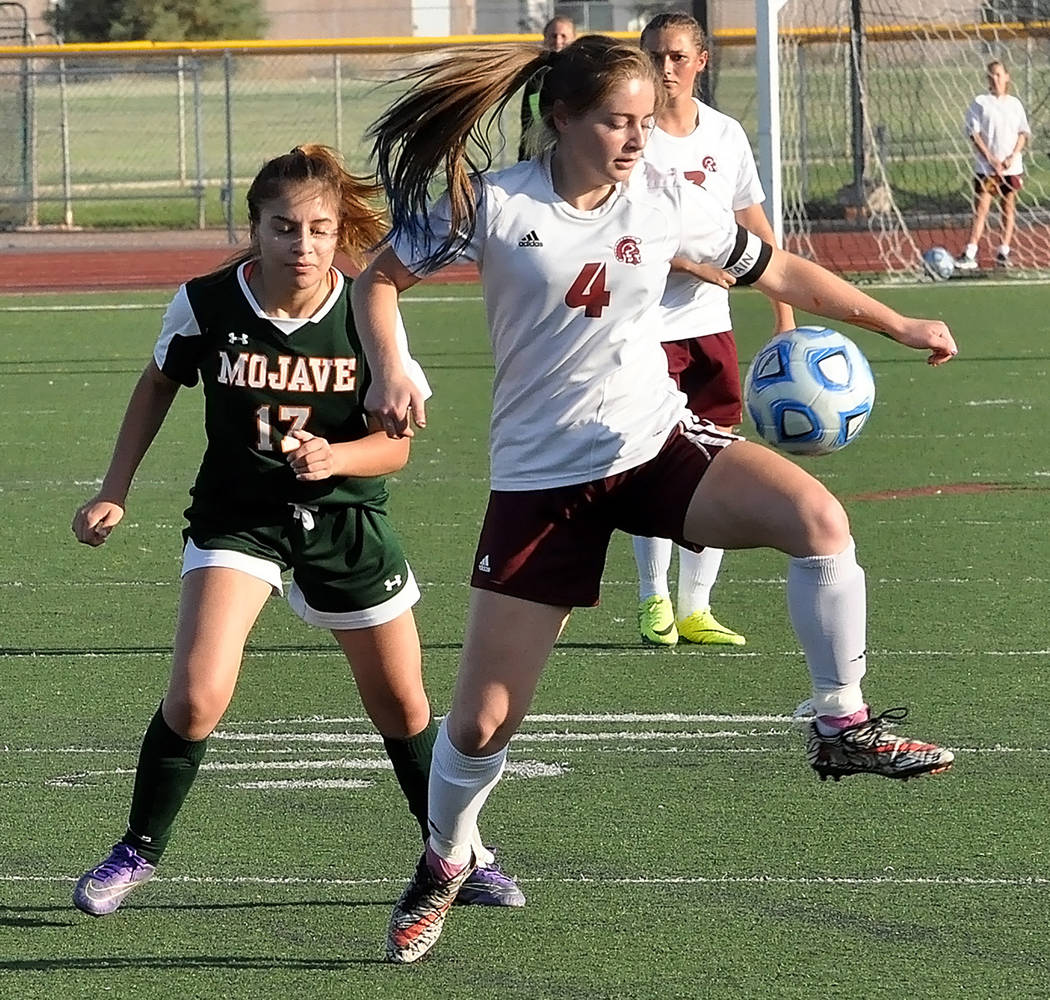Playing 2 sports simultaneously requires more than twice the dedication
This is the first part of a series taking a look at the impact of sports specialization and club sports on high school athletics.
It was the spring of 2017, and Kathy Niles had a dilemma.
Her Pahrump Valley High School softball team was headed toward the playoffs, and she had practice. But Niles also was — and still is — a soccer player, and on one particular day she really wanted to be in two places at once.
“I’m the only one there before practice starts,” remembered Rich Lauver, then as now a volunteer assistant softball coach. “She’s like, ‘hey I’ve got to leave early, I’ve got my soccer tryouts, and I don’t know what to do.’ So I said, ‘What do you plan on doing at the next level? What is your plan here?’ Because I didn’t know.
“She said, ‘Well, I plan on playing college soccer.’ ‘Then you have no choice but to go. You need to go.’ She ended up missing about an hour of practice, but even before that I met with the team. I told them, ‘Hey, Kathy’s going to have to leave a little bit early. She has a great opportunity. We’re a team here, we support each other individually, and we support each other as a group. … If we try to hold her back from that opportunity, she would have resentment and everything else.’ The team basically was, ‘Go get it. Make it happen.’ ”
Lauver remembers taking a great deal of heat for allowing Niles to miss an hour of practice to go to her club tryouts, and Niles said she didn’t play much until the later stages of that season after a conversation with the coach.
“I told him I was going to play club soccer as well, and he told me to my face. ‘If you do both, then I’m not going to give you any playing time on the field,’ ” Niles said from Oskaloosa, Iowa, where she started every game for the William Penn University women’s soccer team this season. “He didn’t want to play me so much. I asked to move down to JV, and he said no. But the last fourth of the season he played me every game because he didn’t have any choice.
“There were times I was like, there’s no point, I should just stick to soccer. But my senior year I figured, I’m a senior, I might as well play. And I played a lot more.”
There was a reason for that. Niles had a different strategy for her final high school season.
“I did not tell him I was playing again,” Niles said.
And a little improvisation was sometimes needed, such as the day she had a soccer game and a softball game on the same day. The school team, of course, rides the bus to away games, and Niles, keeping her soccer playing a secret, certainly was not supposed to be in Las Vegas waiting for her softball team to show up.
“One time I had a game in Vegas, it was midday, and we were supposed to ride the bus to games,” she said. “I scheduled a dentist appointment in Vegas near the field where the game would be at so I wouldn’t have to ride the bus over.”
Larry Goins, who was the PVHS athletic director at the time, would have had an issue with the way Niles’ situation was handled, but he also would have had an issue with not discussing the potential conflicts before they happened.
“I can tell you as the athletic director, I would have issues with any coach that held it against any kid because they were trying to play multiple sports,” Goins said. “If I had to sit down with coaches where there was a conflict, we would come up with what the priorities were going to be. Every school I’ve been at, including Pahrump Valley High School, has a criteria for conflicts. It was first put in there to settle conflicts between band and athletics or choir and athletics, but it works the same way.”
Niles managed simultaneously to start in center field for the Trojans and maintain her position with Downtown Las Vegas Soccer Club’s ‘00 Academy team. And while the Trojans won the Sunset League, Downtown ‘00 won the state club championship and went to the regionals in Hawaii. Goins believes it is very rare for an athlete to be able to do that.
“I think that’s a bit of a stretch,” he said of competing for a school team and a club team during the same season. “I don’t think it’s fair to the kids, and I don’t think it’s fair to either team.”
The borderline-absurd schedule Niles kept up to play both for her school softball team and her club soccer team — and the little white lies that went with it — were worth it.
“We had softball every day, and then we had club soccer on Monday, Tuesday, Thursday, and then on Saturday and Sunday we had games or tournaments,” Niles recalled. “Three or four weeks when we were in league play for club soccer I’d have to go from a softball game right to a soccer game.”
Nobody forced her to do all that; she felt she needed to play club soccer for her future, and she wanted to play high school softball because she enjoyed the game, if not everything that went with it.
Niles was not the only one who did that; in fact, she wasn’t even the only one in her class to do it. Sydney Dennis also wanted to play club soccer for her future, and it worked. A standout for Players Soccer Club’s 1999 Girls Elite Team, Dennis also helped her club win a state title and go to regionals during the same spring during which she ran track for Pahrump Valley High School.
There are far fewer track meets than softball games during a spring season, and once you qualify for the postseason, track season becomes more or less pointless, but the commute to Las Vegas for practices and games remains difficult.
“It was pretty challenging, but I think it was good that I did that,” said Dennis, who plays soccer for Northern Arizona University. “I had taken a break from track the year before because I was a little burnt out and exhausted from how much I was doing, but I think it was a positive experience and a good way to end high school.”
For Dennis, it might have been a positive experience to do both sports during the same season, but make no mistake: Soccer was her ticket. Dennis is the only former Pahrump Valley High School athlete currently playing at the highest level of collegiate sports, as NAU is a member of the Big Sky Conference in the NCAA’s Division I.
She doesn’t get there without Players SC. As Lauver says, “I guarantee you a college coach is not going to ask how you did against Sunrise Mountain.”
In Niles’ case, there is a bit of irony. She indeed went beyond playing Sunrise Mountain, but she did not give up playing another sport she enjoyed, even if she had to keep playing soccer a secret, and even though a former soccer coach said giving up softball would be necessary to her future soccer success.
“I was told by the coach before Julie (Carrington) that I would never be successful if I didn’t specialize in soccer,” she said. “But I look at it now, and I’m playing at a university, starting as a sophomore and I’m a captain … They say that specialization is so important, but look at me now. I didn’t specialize all through high school.”
In Part 2: Several athletes graduating this spring have committed to playing a sport in college, and they have something in common.




















